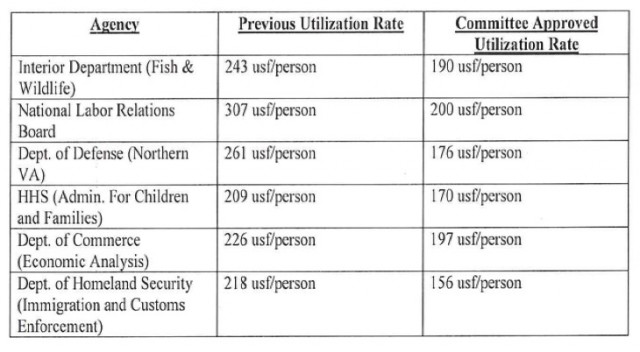The trend in space utilization is towards greater efficiency, mobile work and collaborative workspaces. As we have discussed many times on this blog (including here and here), the federal government has embarked on efforts across its leased and owned inventory to improve space utilization. The workplace is changing for federal agencies just as it is for private companies. It is a very real macro trend at work across the office sector.
This photo of GSA’s renovated Washington, DC headquarters is indicative of its aspirations for the federal agencies it serves: Lots of benching, areas for collaboration, etc. GSA achieved space utilization of just 82 USF/person in this redesigned space. It represents the extreme in space efficiency and it is designed largely on the premise that many federal workers are mobile working.
And, increasingly, they are. Telework is a significant catalyst for the changes occurring in federal office design. The Telework Enhancement Act was signed into law in 2010 and it has served to siphon off demand for traditional offices. About 680,000 federal employees are eligible to telework (nearly 1/3 of the federal civilian workforce). Last year almost 170,000 federal employees were teleworking at least one day per week. Yet, telework has put only a small dent in overall space demand. That’s because if a worker teleworks his/her office remains empty. Now the effort is to reconfigure these workspaces to better enable mobile work and allow for desk sharing.
I know what you’re thinking: It’s pie-in-the-sky, right? GSA may want to implement changes but in the current budget environment will it really happen? Costs to reconfigure space can be quite expensive. Even if landlords contribute TI allowances to pay for much of it, some portion of the cost will be borne by the cash-strapped agencies. Further, maybe the agencies pay lip-service to efficiency but they really don’t want to implement it. If DOJ can’t provide offices for its attorneys and NIH can’t provide offices for its PhDs, surely it will impede their ability to recruit and retain the best of breed. Agencies will find a way around the space utilization edicts. There are all sorts of reasons change will never actually happen. Right?
Wrong.
Though we may expect some clever gamesmanship from the agencies, Congress holds the trump card. That is because Congress has the power to review and approve prospectus leases–the largest leases in GSA’s inventory. A recent report by the General Accounting Office (GAO) estimates that there are 218 GSA leases subject to congressional review. That is just 2% of the roughly 8,800 GSA leases but this small number of leases comprises more than 1/3 of both the square footage and rent in GSA’s 200 MSF leased inventory.
The 112th and the (current) 113th Congress have wielded this power forcefully. In recent years, the House of Representatives has included a press release with each batch of prospectus authorizations that specifically notes the “savings” it created by requiring GSA to improve utilization. The chart below is clipped from one such press release issued in May of this year. The impact on space utilization and net demand are apparent.
Looking forward, the federally leased market must adjust to these tighter standards. The process will take time–it won’t be the click of a reset button. We can expect the downsizing to be a gradual shift but, to be clear, the die has already been cast in several transactions. An example is the recent U.S. Fish and Wildlife Service (FWS) lease in Northern Virginia. This lease serves to shrink FWS’ footprint from 258,000 RSF to 183,000 RSF. The effect of this downsizing won’t be felt until FWS occupies its new quarters, but it’s going to happen. Similar transactions will follow.
Smaller leases will be downsized as well and we have already seen anecdotal evidence of it. In some of these instances, the government’s zeal for downsizing is arguably counterproductive, generating significant costs and loss of core factor efficiency to achieve a small reduction in its goal metric: square footage. We hope GSA won’t become too robotic in its approach to downsizing, yet downsizing will occur nonetheless.
Small leased locations in multi-tenant buildings are in particular danger of being eliminated when they can be consolidated into larger leased or owned facilities nearby. One of the new due diligence maxims is “beware the spillover lease.” If you see a fully leased government building with that same agency occupying a small lease of additional space in a building next door, it’s likely that the spillover lease is being considered for elimination.
Perhaps most troublesome for lessors, the traditional “incumbent advantage” is substantially eroded in those instances where the government’s space features the hard-walled offices and center corridors so typical of space design in the 1990s and earlier. Where the space must be completely re-built to accommodate new open-plan space designs, incumbent lessors will have no real cost advantage in retaining the tenant and, in fact, may incur additional expense if they must provide “swing space” to construct the new improvements.
That’s the scary part. The good news is that there is time to prepare. Downsizing will occur as leases expire and–though about 44 MSF of leases expire in the next two years–we can expect most agencies to “kick the can” a bit as they work through the planning and budgeting required to shrink their footprint. The additional good news for current lessors is that agencies could really benefit from your capital. If you are proactive, there may be opportunities to make investments now to ensure long-term occupancy.
The bottom line is this: Navigating through this period will require much more due diligence when buying properties, and owners of buildings already leased to the government can’t simply wait for the phone to ring with a renewal request. Even if your lease is years from expiring, it is time to develop a strategy now.


